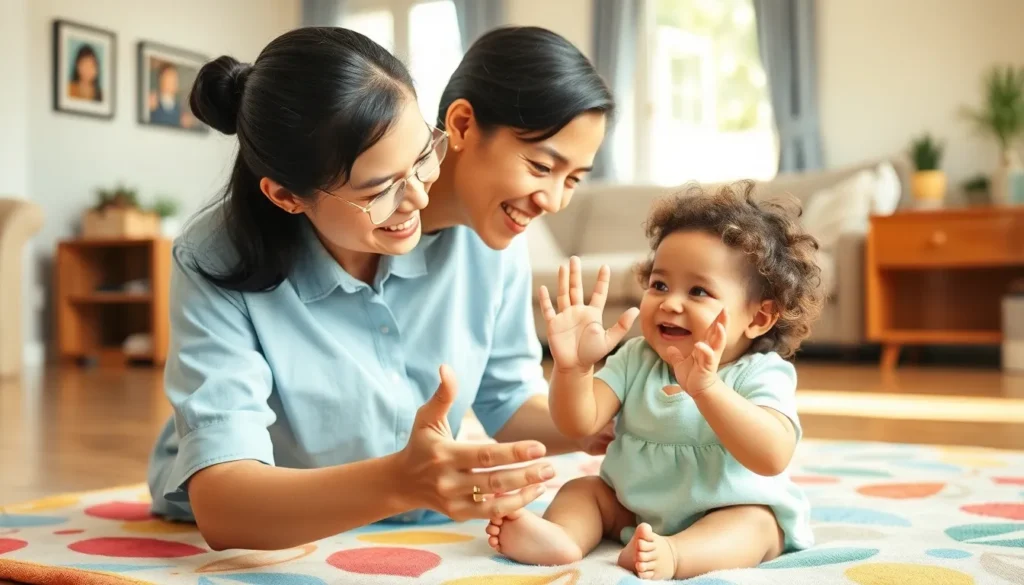Table of Contents
ToggleImagine a world where your little one can express gratitude without uttering a single word. That’s right! Teaching babies to say “thank you” in sign language is not just adorable; it’s a game changer. This simple gesture opens the door to communication, fostering a sense of empathy and connection even before they can speak.
Overview of Sign Language for Babies
Sign language offers a valuable communication tool for babies. This method allows infants to express needs and feelings before they articulate spoken words. Many parents observe a significant increase in their child’s ability to communicate and connect with others through these gestures.
Learning basic signs can enhance a baby’s ability to express gratitude. For instance, the sign for “thank you” involves a simple motion that can be easily mastered. Observing parents demonstrate this sign encourages babies to mimic them, promoting further engagement.
Research suggests that incorporating sign language in early development can boost cognitive and language skills. Studies indicate that babies who learn signs often exhibit enhanced verbal abilities later. Engaging in sign language helps build a strong foundation for effective life-long communication.
Teachers and caregivers play a crucial role in modeling these signs. Consistent practice in various contexts reinforces understanding and retention. Incorporating sign language into daily routines, like mealtime or playtime, can make learning dynamic and enjoyable.
This non-verbal communication fosters emotional connections. Responding to a child’s signed expression of gratitude nurtures their sense of self-worth and social awareness. As the child grows, these early interactions form a basis for empathetic relationships with others.
Employing sign language proves beneficial for both infants and caregivers. It creates a shared language that can bridge the gap between expectation and expression. Teaching simple signs offers a unique opportunity for emotional development and deeper family ties.
Importance of Teaching Sign Language

Teaching sign language to babies significantly enhances their ability to communicate needs before verbal skills develop. This early introduction of non-verbal communication fosters a strong foundation for understanding.
Benefits for Communication Skills
Babies benefit from learning sign language as it boosts their communication skills. Signs enable infants to convey requests and feelings, which can reduce frustration. Research consistently shows that children familiar with signs often demonstrate improved vocabulary as they grow. Parents notice these advancements, leading to a more effective exchange of thoughts. Enhanced communication also encourages social skills, allowing babies to interact meaningfully with peers and caregivers.
Enhancing Bonding Between Parents and Babies
Bonding experiences flourish when parents teach their babies sign language. Engaging in this shared learning activity strengthens emotional ties. Infants feel more valued, as their efforts to communicate are recognized and reciprocated. Regular practice of signs creates joyful moments, reinforcing trust and security. Observing a child’s eagerness to express gratitude, such as with the sign for “thank you,” deepens the connection between parent and baby, leading to a nurturing caregiving environment.
How to Teach “Thank You” in Sign Language
Teaching “thank you” in sign language enhances a baby’s ability to express gratitude. Start by facing your baby and making the sign while saying “thank you” aloud. Use your dominant hand to extend your fingers and place them near your chin, moving outward slightly. Encourage your baby to mimic this gesture. Regularly demonstrating the sign during moments of appreciation reinforces its meaning.
Step-by-Step Instructions
- Position: Sit at eye level with your baby.
- Gesture: Use your dominant hand to touch your chin, then move it away from your face.
- Repetition: Repeat the sign consistently when expressing gratitude.
- Encouragement: Cheer when your baby attempts the sign.
- Pairing: Connect the sign with verbal “thank you” to strengthen understanding.
Tips for Effective Learning
Practice daily to build familiarity with the sign. Utilize positive reinforcement to encourage attempts. Incorporate the sign during daily activities, such as meal times or play sessions. Use visuals, like picture books, to reinforce the concept. Engage siblings or family members to create a supportive environment for learning. Consistency creates a sense of security and deepens connection.
Common Mistakes to Avoid
Many parents misunderstand the timing for introducing sign language. They often wait until a baby shows signs of frustration with verbal communication. Starting early fosters a more effective learning environment.
Using inconsistent signs can hinder a baby’s ability to learn. Frequent changes in how signs are demonstrated lead to confusion. Consistency enhances recognition and build confidence in using signs.
Neglecting to practice daily limits a baby’s progress. Regular reinforcement is crucial for retaining the signs. Engaging in short, frequent sessions improves retention and understanding.
Some parents forget to make learning interactive. Children benefit from lively engagement. Incorporating games or songs related to sign language creates a joyful learning experience.
Overlooking the role of non-verbal cues can be a setback. Babies also communicate through facial expressions and body language. Acknowledging these cues enriches overall communication.
Failing to encourage mimicry can diminish confidence. Parents should actively invite babies to replicate signs. Gentle encouragement fosters a sense of accomplishment and reinforces learning.
Not involving other caregivers leads to mixed messaging. Family members should learn the same signs to create a cohesive communication approach. This shared understanding strengthens connections between the baby and various caregivers.
Ignoring the emotional aspect of signing impairs engagement. Expressing enthusiasm about signs makes learning enjoyable. Recognizing achievements, no matter how small, motivates continued practice and fosters a supportive environment.
Additional Signs to Teach Your Baby
Teaching additional signs enhances a baby’s communication skills. Starting with simple gestures fosters understanding and interaction. “More” signifies wanting something, encouraging babies to express desires. Demonstrating this sign involves placing fingertips of both hands together and tapping them.
“Please” promotes polite behavior in children. Forming an “open hand” and moving it in a circular motion on the chest represents this gesture. Practicing this sign encourages gratitude and relationships in social environments.
“Help” holds significance in fostering independence and awareness. To show this, place one hand under the opposite elbow and lift gently. This gesture invites babies to seek assistance when needed.
“Eat” represents hunger effectively, allowing babies to express needs. Training involves placing fingers to the mouth, mimicking the action of eating. Associating this sign with mealtime encourages communication about food preferences.
“All done” signals a completed task or finished activity. Raising both hands to shoulder height and waving them expresses this concept clearly. This sign can be used during playtime or feeding, indicating a transition.
Involving family members supports learning many signs. Engaging siblings and caregivers fosters a community during this educational journey. Regular practice creates a joyful environment and reinforces positive communication habits.
Encouragement through games promotes retention of these signs. Incorporating playtime enhances learning and makes communication fun. Using everyday situations provides ample opportunity for practice and familiarity with signs, aiding in overall development.
Teaching babies to sign “thank you” opens up a world of communication that enriches their early development. This simple gesture fosters a sense of gratitude and connection between parents and children. As infants learn to express their appreciation through sign language they not only enhance their vocabulary but also build essential social skills.
The practice of incorporating sign language into daily routines creates joyful interactions that strengthen emotional bonds. Parents who engage in this learning journey witness their child’s growth in both communication and confidence. By embracing sign language as a tool for expression families can cultivate an environment where gratitude and understanding thrive.




